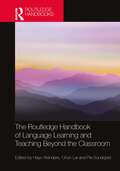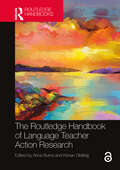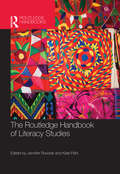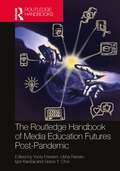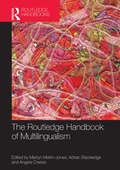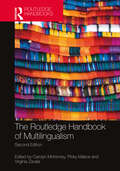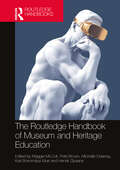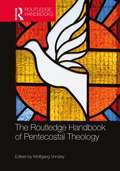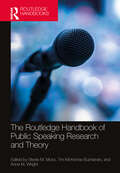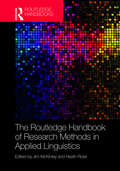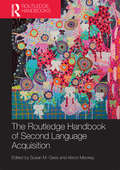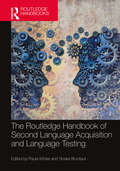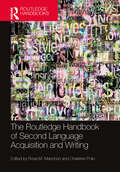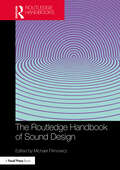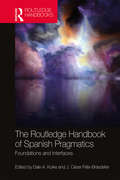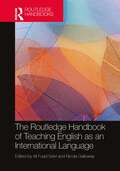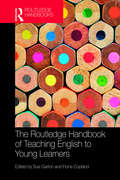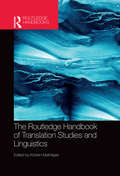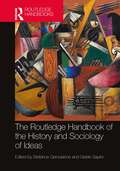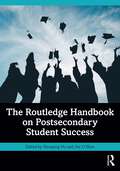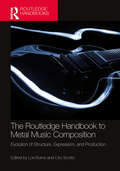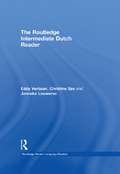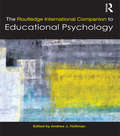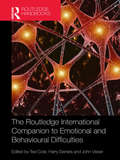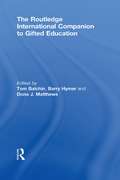- Table View
- List View
The Routledge Handbook of Language Learning and Teaching Beyond the Classroom (Routledge Handbooks in Applied Linguistics)
by Hayo ReindersInformal language learning beyond the classroom plays an important and growing role in language learning and teaching. This Handbook brings together the existing body of research and unites the various disciplines that have explored this area, in order to present the current state of knowledge in one accessible resource. Much of adult learning takes place outside of formal education and for language learning, it is likely that out-of-class experiences play an equally important role. It is therefore surprising that the role of informal language learning has received little attention over the years, with the vast majority of research instead focusing on the classroom. Researchers from a range of backgrounds, however, have started to realise the important contribution of informal language learning, both in its own right, and in its relationship with classroom learning. Studies in the areas of learner autonomy, learning strategies, study abroad, language support, learners’ voices, computer-mediated communication, mobile-assisted language learning, digital gaming, and many others, all add to our understanding of the complex and intersecting ways in which learners construct their own language learning experiences, drawing from a wide range of resources, including materials, teachers, self-study, technology, other learners and native speakers. This Handbook provides a sound and comprehensive basis for researchers and graduate students to build upon in their own research of language learning and teaching beyond the classroom.
The Routledge Handbook of Language Teacher Action Research (Routledge Handbooks in Applied Linguistics)
by Anne Burns Kenan DikilitaşThe Routledge Handbook of Language Teacher Action Research is an authoritative and innovative treatment of language teacher action research (LTAR) as a growing research field.Edited by two global thought leaders in LTAR, it features 34 original thematic contributions from a global range of experts at the cutting edge of the field, providing a comprehensive survey not found in any other single publication. Initiatives across the world are demonstrating the value of LTAR, which has been shown to provide language teachers with strong, exciting, and influential opportunities for learning, and gaining a feeling of empowerment. This groundbreaking Handbook theorises these premises from multiple perspectives in specific areas of language teacher education and curates a broad range of original content that integrates the practical and theoretical knowledge that has emerged over the years since LTAR began to develop.This volume is a groundbreaking guide for researchers of language teaching, as well as practitioners and educators that want to harness the potential of LTAR in both theory and practice.
The Routledge Handbook of Literacy Studies (Routledge Handbooks in Applied Linguistics)
by Jennifer Rowsell Kate PahlThe Routledge Handbook of Literacy Studies offers a comprehensive view of the field of language and literacy studies. With forty-three chapters reflecting new research from leading scholars in the field, the handbook pushes at the boundaries of existing fields and combines with related fields and disciplines to develop a lens on contemporary scholarship and emergent fields of inquiry. The Handbook is divided into eight sections: The foundations of literacy studies Space-focused approaches Time-focused approaches Multimodal approaches Digital approaches Hermeneutic approaches Making meaning from the everyday Co-constructing literacies with communities This is the first handbook of literacy studies to recognise new trends and evolving trajectories together with a focus on radical epistemologies of literacy. The Routledge Handbook of Literacy Studies is an essential reference for undergraduate and postgraduate students and those researching and working in the areas of applied linguistics and language and literacy.
The Routledge Handbook of Media Education Futures Post-Pandemic (Routledge Research in Media Literacy and Education)
by Yonty Friesem Usha Raman Grace Y. Choi Igor KanižajThis handbook showcases how educators and practitioners around the world adapted their routine media pedagogies to meet the challenges of the COVID-19 pandemic, which often led to significant social, economic, and cultural hardships. Combining an innovative mix of traditional chapters, autoethnography, case studies, and dialogue within an intercultural framework, the handbook focuses on the future of media education and provides a deeper understanding of the challenges and affordances of media education as we move forward. Topics range from fighting disinformation, how vulnerable communities coped with disadvantages using media, transforming educational TV or YouTube to reach larger audiences, supporting students’ wellbeing through various online strategies, examining early childhood, parents, and media mentoring using digital tools, reflecting on educators’ intersectionality on video platforms, youth-produced media to fight injustice, teaching remotely and providing low-tech solutions to address the digital divide, search for solutions collaboratively using social media, and many more. Offering a unique and broad multicultural perspective on how we can learn from the challenges of addressing varied pedagogical issues that have arisen in the context of the pandemic, this handbook will allow researchers, educators, practitioners, institution leaders, and graduate students to explore how media education evolved during 2020 and 2021, and how these experiences can shape the future direction of media education.
The Routledge Handbook of Multilingualism (Routledge Handbooks in Applied Linguistics)
by Angela Creese Adrian Blackledge Edited by Marilyn Martin-JonesThe Routledge Handbook of Multilingualism provides a comprehensive survey of the field of multilingualism for a global readership, and an overview of the research which situates multilingualism in its social, cultural and political context. The handbook includes an introduction and five sections with thirty two chapters by leading international contributors. The introduction charts the changing landscape of social and ethnographic research on multilingualism (theory, methods and research sites) and it foregrounds key contemporary debates. Chapters are structured around sub-headings such as: early developments, key issues related to theory and method, new research directions. This handbook offers an authoritative guide to shifts over time in thinking about multilingualism as well as providing an overview of the range of contemporary themes, debates and research sites. The Routledge Handbook of Multilingualism is the ideal resource for postgraduate students of multilingualism, as well as those studying education and anthropology.
The Routledge Handbook of Multilingualism (Routledge Handbooks in Applied Linguistics)
by Virginia Zavala Carolyn McKinney Pinky MakoeThe Routledge Handbook of Multilingualism provides a comprehensive survey of the field of multilingualism for a global readership and an overview of the research which situates multilingualism in its social, cultural and political context. This fully revised edition not only updates several of the original chapters but introduces many new ones that enrich contemporary debates in the burgeoning field of multilingualism. With a decolonial perspective and including leading new and established contributors from different regions of the globe, the handbook offers a critical overview of the interdisciplinary field of multilingualism, providing a range of central themes, key debates and research sites for a global readership. Chapters address the profound epistemological and ontological challenges and shifts produced since the first edition in 2012. The handbook includes an introduction, five parts with 28 chapters and an afterword. The chapters are structured around sub-themes, such as Coloniality and Multilingualism, Concepts and Theories in Multilingualism, and Multilingualism and Education. This ground-breaking text is a crucial resource for researchers, scholars and postgraduate students interested in multilingualism from areas such as sociolinguistics, applied linguistics, anthropology and education.
The Routledge Handbook of Museum and Heritage Education (Routledge Handbooks on Museums, Galleries and Heritage)
by Michelle Delaney Pete Brown Maggie McColl Karl Borromäus Murr Henrik ZipsaneThe Routledge Handbook of Museum and Heritage Education is a practical reference guide that shows how museums, galleries and heritage sites can offer opportunities for successful visitor engagement.Defining museums as all cultural sites that interpret collections and spaces for public education, understanding, and enjoyment, this volume argues that museum education has a central role in the development of policies, practices, and research for engagement. Including contributions from experts across the globe, the volume shows how these sites can continue to offer unique opportunities for social, physical, emotional, and academic engagement that are much needed to inform and empower museum visitors internationally. It also demonstrates how museums, galleries, and heritage sites can be utilised for the betterment and sustainability of our world and the societies we live in. Combining rich theory with innovative practice, this book provides a comprehensive analysis of museum and heritage education today.The Routledge Handbook of Museum and Heritage Education will be of interest to academics, students, and professionals who are based in the fields of museum education, heritage, adult and community education, cultural studies, social studies, psychology, and tourism.
The Routledge Handbook of Pentecostal Theology (Routledge Handbooks in Theology)
by Wolfgang VondeyResearch on Pentecostal and Charismatic Christianity has increased dramatically in recent decades, and a diverse array of disciplines have begun to address a range of elements of these movements. Yet, there exists very little understanding of Pentecostal theology, and it is not uncommon to encounter stereotypes and misperceptions. Addressing this gap in current research, The Routledge Handbook of Pentecostal Theology is an exceptional reference source to the key topics, challenges, and debates in this growing field of study and is the first collection of its kind to offer a comprehensive presentation and critical discussion of this subject. Comprising over forty chapters written by a team of international contributors, the Handbook is divided into five parts: Contextualizing Pentecostal Theology Sources Theological Method Doctrines and Practices Conversations and Challenges. These sections take the reader through a comprehensive introduction to what Pentecostals believe and how they practice their faith. Looking at issues such as the core teachings of Pentecostalism concerning Spirit baptism, divine healing, or eschatology; unique practices, such as spiritual warfare and worship; and less discussed issues, such as social justice and gender, each chapter builds towards a nuanced and global picture of the theology of the Pentecostal movement. The Routledge Handbook of Pentecostal Theology is essential reading for students and researchers in Pentecostal Studies, World Christianity, and Theology as well as scholars working in contemporary Religious Studies.
The Routledge Handbook of Public Speaking Research and Theory (Routledge Handbooks in Communication Studies)
by Stevie M. Munz, Tim McKenna-Buchanan, and Anna M. WrightProviding a comprehensive survey of the empirical research, theory, and history of public speaking, this handbook fills a crucial gap in public speaking pedagogy resources and provides a foundation for future research and pedagogical development.Bringing together contributions from both up-and-coming and senior scholars in the field, this book offers a thorough examination of public speaking, guided by research across six key themes: the history of public speaking; the foundations of public speaking; issues of diversity, equity, and inclusion; considerations of public speaking across contexts; assessment of public speaking; and the future of public speaking in the twenty-first century. The evidence-based chapters engage with a broad discussion of public speaking through a variety of viewpoints to demonstrate how subtopics are connected and fraught with complexity. Contributors explore public speaking in education, business and professional settings, and political contexts, and outline how skills learned through public speaking are applicable to interpersonal, small group, and business interactions.Reinforcing the relevance, importance, and significance of public speaking in individual, interpersonal, social, and cultural communication contexts, this accessibly written handbook will be an indispensable resource for public speaking instructors and program administrators. It will also be valuable reading for Communication Pedagogy and Introduction to Graduate Studies courses.
The Routledge Handbook of Research Methods in Applied Linguistics (Routledge Handbooks in Applied Linguistics)
by Heath Rose Jim McKinleyThe Routledge Handbook of Research Methods in Applied Linguistics provides a critical survey of the methodological concepts, designs, instruments and types of analysis that are used within the broad field of applied linguistics. With more than 40 chapters written by leading and emerging scholars, this book problematizes and theorizes applied linguistics research, incorporating numerous multifaceted methodological considerations and pointing to the future of good practice in research. Topics covered include: key concepts and constructs in research methodology, such as sampling strategies and mixed methods research; research designs such as experimental research, case study research, and action research; data collection methods, from questionnaires and interviews to think-aloud protocols and data elicitation tasks; data analysis methods, such as use of R, inferential statistical analysis, and qualitative content analysis; current considerations in applied linguistics research, such as a need for transparency and greater incorporation of multilingualism in research; and recent innovations in research methods related to multimodality, eye-tracking, and advances in quantitative methods. The Routledge Handbook of Research Methods in Applied Linguistics is key reading for both experienced and novice researchers in Applied Linguistics as well as anyone undertaking study in this area.
The Routledge Handbook of Second Language Acquisition (Routledge Handbooks in Applied Linguistics)
by Alison Mackey Susan M. GassThe Routledge Handbook of Second Language Acquisition brings together fifty leading international figures in the field to produce a state-of-the-art overview of Second Language Acquisition. The Handbook covers a wide range of topics related to Second Language Acquisition: language in context, linguistic, psycholinguistic, and neurolinguistic theories and perspectives, skill learning, individual differences, L2 learning settings, and language assessment. All chapters introduce the reader to the topic, outline the core issues, then explore the pedagogical application of research in the area and possible future development. The Routledge Handbook of Second Language Acquisition is an essential resource for all those studying and researching Second Language Acquisition.
The Routledge Handbook of Second Language Acquisition and Language Testing (The Routledge Handbooks in Second Language Acquisition)
by Paula Winke and Tineke BrunfautThis Handbook, with 45 chapters written by the world’s leading scholars in second language acquisition (SLA) and language testing, dives into the important interface between SLA and language testing: shared ground where researchers seek to measure second language performance to better understand how people learn their second languages. The Handbook also reviews how to best measure and evaluate the second language (L2) learners’ personal characteristics, backgrounds, and learning contexts to better understand their L2 learning trajectories. Taking a transdisciplinary approach to research, the book builds upon recent theorizing and measurement principles from the fields of applied linguistics, cognitive science, psychology, psycholinguistics, psychometrics, educational measurement, and social psychology. The Handbook is divided into six key sections: (1) Assessment concepts for SLA researchers, (2) Building instruments for SLA research, (3) Measuring individual differences, (4) Measuring language development, (5) Testing specific populations, and (6) Measurement principles for SLA researchers.
The Routledge Handbook of Second Language Acquisition and Writing (The Routledge Handbooks in Second Language Acquisition)
by Rosa M. ManchónThis unique state-of-the-art volume offers a comprehensive, systematic discussion of second language (L2) writing and L2 learning. Led by experts Rosa Manchón and Charlene Polio, top international scholars synthesize and contextualize the salient theoretical approaches, methodological issues, empirical findings, and emerging themes in the connection between L2 writing and L2 learning, and set the future research agenda to move the field forward. This will be an indispensable resource for scholars and students of second language acquisition (SLA), applied linguistics, education, and composition studies.
The Routledge Handbook of Sound Design
by Michael FilimowiczThe Routledge Handbook of Sound Design offers a comprehensive overview of the diverse contexts of creativity and research that characterize contemporary sound design practice. Readers will find expansive coverage of sound design in relation to games, VR, globalization, performance, soundscape and feminism, amongst other fields.Half a century since its formal emergence, this book considers sound design in a plethora of practical contexts, including music, film, soundscape and sonification, as well as the emerging theoretical and analytical approaches being used in scholarship on the subject. The Routledge Handbook of Sound Design tracks how ideas and techniques have migrated from one field to the next, as professionals expand the industry applications for their skills and knowledge, and technologies produce new form factors for entertainment and information.Collectively, the chapters included in this volume illustrate the robustness and variety of contemporary sound design research and creativity, making The Routledge Handbook of Sound Design essential reading for students, teachers, researchers and practitioners working on sound design in its many forms.
The Routledge Handbook of Spanish Pragmatics: Foundations and Interfaces (Routledge Spanish Language Handbooks)
by J. César Félix-Brasdefer Dale A. KoikeThe Routledge Handbook of Spanish Pragmatics is the first volume to offer a comprehensive overview of advances in Spanish Pragmatics, addressing different types of interaction and the variables, both social and linguistic, that can affect them. Written by a diverse set of experts in the field, the handbook unifies two major approaches to the study of pragmatics, the Anglo-American and European Continental traditions. Thirty-three chapters cover in detail both pragmatic foundations (e.g. speech act theory, implicature and relevance, deixis) and interfaces with other concepts, including: • Discourse • Variation; Culture and interculture • (Im)politeness; humor • Learning contexts and teaching • Technology This is an ideal reference for advanced undergraduate and postgraduate students, and researchers of Spanish language and linguistics.
The Routledge Handbook of Teaching English as an International Language (Routledge Handbooks in Applied Linguistics)
by Nicola Galloway Ali Fuad SelviThe Routledge Handbook of Teaching English as an International Language provides a ground-breaking overview of the research on the global spread of English with pedagogical implications. Bringing together a number of key scholars and scholarly discussions on various aspects of teaching English as an International Language (TEIL), this handbook directs research in this field to help inform the much-needed paradigm shift in ELT away from idealized native English-speaking norms.Reframing English language, language teaching, and teacher education to match the new sociolinguistic landscape of the 21st century, this handbook analyzes this topic in seven key areas: Theoretical considerations Major frameworks and proposals Principles and practices of teaching and assessing English Innovative approaches, varied contexts, and transformative practices Diverse teaching settings and populations Teacher education and professional development Research developments and future directions The Routledge Handbook of Teaching English as an International Language is essential reading for scholars and students researching in the areas of World Englishes, English as a lingua franca, English as an international language, Global Englishes, ELT, sociolinguistics, and critical applied linguistics.
The Routledge Handbook of Teaching English to Young Learners (Routledge Handbooks in Applied Linguistics)
by Fiona Copland Sue GartonThe Routledge Handbook of Teaching English to Young Learners celebrates the ‘coming of age’ for the field of research in primary-level English Language Teaching. With 32 chapters written by international scholars from a wide geographical area including East Africa, Mexico, the South Pacific, Japan, France, the USA and the UK, this volume draws on areas such as second language acquisition, discourse analysis, pedagogy and technology to provide: An overview of the current state of the field, identifying key areas of TEYL. Chapters on a broad range of subjects from methodology to teaching in difficult circumstances and from Content and Language Integrated Learning (CLIL) to gaming. Suggestions of ways forward, with the aim of shaping the future research agenda of TEYL in multiple international contexts. Background research and practical advice for students, teachers and researchers. With extensive guidance on further reading throughout, The Routledge Handbook of Teaching English to Young Learners is essential reading for those studying and researching in this area.
The Routledge Handbook of Translation Studies and Linguistics (Routledge Handbooks in Translation and Interpreting Studies)
by Kirsten MalmkjærThe Routledge Handbook of Translation Studies and Linguistics explores the interrelationships between translation studies and linguistics in six sections of state-of-the-art chapters, written by leading specialists from around the world. The first part begins by addressing the relationships between translation studies and linguistics as major topics of study in themselves before focusing, in individual chapters, on the relationships between translation on the one hand and semantics, semiotics and the sound system of language on the other. Part II explores the nature of meaning and the ways in which meaning can be shared in text pairs that are related to each other as first-written texts and their translations, while Part III focuses on the relationships between translation and interpreting and the written and spoken word. Part IV considers the users of language and situations involving more than one language and Part V addresses technological tools that can assist language users. Finally, Part VI presents chapters on the links between areas of applied linguistics and translation and interpreting. With an introduction by the editor and an extensive bibliography, this handbook is an indispensable resource for advanced students of translation studies, interpreting studies and applied linguistics.
The Routledge Handbook of the History and Sociology of Ideas
by Stefanos GeroulanosThe Routledge Handbook of the History and Sociology of Ideas establishes a new and comprehensive way of working in the history and sociology of ideas, in order to obviate several longstanding gaps that have prevented a fruitful interdisciplinary and international dialogues. Pushing global intellectual history forward, it uses methodological innovations in the history of concepts, gender history, imperial history, and history of normativity, many of which have emerged out of intellectual history in recent years, and it especially foregrounds the role of field theory for delimiting objects of study but also in studying transnational history and migration of persons and ideas. The chapters also explore how intellectual history crosses the study of particular domains: law, politics, economy, science, life sciences, social and human sciences, book history, literature, and emotions.
The Routledge Handbook on Postsecondary Student Success
by Shouping Hu Joe O’SheaThe Routledge Handbook on Postsecondary Student Success offers a comprehensive and authoritative examination of student success in postsecondary education.This handbook addresses critical issues in student success, such as student engagement, mental health, and degree completion to provide valuable insights on promoting student success holistically and systematically, for students from different backgrounds or in different institutional contexts. It also offers a robust understanding of how to study and enhance student success by exploring the significance of data, analytics, and various research methods. Using evidence-based insights and practical strategies and offering key concepts, theories, and best practices, this handbook serves as a guide to promoting overall student success and closing success gaps.With forty chapters authored by leading thinkers in higher education, this handbook is an indispensable resource for postsecondary administrators, faculty, staff, practitioners, graduate students, researchers, and policymakers. It informs and inspires efforts to improve student outcomes and create more supportive environments, so students everywhere can succeed and flourish.
The Routledge Handbook to Metal Music Composition: Evolution of Structure, Expression, and Production (Routledge Music Handbooks)
by Lori Burns Ciro ScottoThe Routledge Handbook to Metal Music Composition: Evolution of Structure, Expression, and Production examines metal music composition as a distinct practice that combines a complex array of formal musical, expressive, and technological elements. Reaching beyond the limitations of applying common-practice theories of tonality to metal, this volume brings together a wide range of established and emerging scholars to address the building blocks of metal composition in the context of metal’s subgenres and evolution over time. Together, the chapters provide a holistic theoretical framework for understanding the distinctive compositional features of metal.With contributions from an international group of experts, the handbook is organized into four parts around major themes:• Structures, including form, riff, harmony, rhythm, and meter• Expressions and Techniques: Instruments• Expressions and Techniques: Voices• Productions, addressing the role of gear, capturing, processing, and mixing technologies.The contributors examine and discuss these elements with the goal of building an understanding of metal music composition that can also function as a manual for composing metal music. Providing a comprehensive overview of the unique musical elements of metal, this handbook is an essential resource for scholars and students across popular music studies, musicology, creative music performance and composition, songwriting, and production studies, as well as for anyone interested in understanding metal from the perspective of composition.
The Routledge Intermediate Dutch Reader
by Eddy Verbaan Christine Sas Janneke LouwerseThe Routledge Intermediate Dutch Reader has been specially designed for upper intermediate learners of Dutch and comprises a broad selection of graded readings. The readings are taken from a range of contemporary Dutch writing, from newspapers and magazines through to specialist journals and the internet. The texts have been specifically selected to ensure students receive maximum exposure to topics pertaining to Dutch language, culture and society, making this Reader an enjoyable and stimulating resource with a meaningful cultural context. Each reading is fully supported by: a general introduction a vocabulary list with example sentences a number of text comprehension questions and extensive vocabulary exercises with model answers provided in the key a wide variety of speaking exercises relevant to the vocabulary and topic at hand a number of internet research tasks a short list of suggested further reading. A full glossary of words, an overview of fixed word combinations and an outline of irregular verbs are also available as free downloads at http://www.routledge.com/books/details/9780415550086/ Suitable for both class use and independent study, The Routledge Intermediate Dutch Reader is an essential tool for facilitating vocabulary learning and increasing reading proficiency.
The Routledge International Companion to Educational Psychology
by Andrew J. HollimanThe Routledge International Companion to Educational Psychology brings together expert practitioners, researchers, and teachers from five continents to produce a unique and global guide to the core topics in the field. Each chapter includes coverage of the key thinkers, topic areas, events, and ideas that have shaped the field, but also takes the reader beyond typical textbook material and into engagement with current issues, cutting-edge research and future directions in the field of educational psychology from an international perspective. With over 30 chapters, the volume is divided into four themed sections: ‘An introduction to educational psychology’, ‘How children learn and develop’, ‘Issues concerning the assessment of children’ and ‘Identifying and meeting the needs of children with learning difficulties’. Covering the key issues and fundamental strands of educational psychology The Routledge International Companion to Educational Psychology aims to provide the reader with knowledge of: educational psychology (history, child rights, and practice); factors which influence children’s learning and development; issues to do with assessment (a key aspect of educational psychology); special educational needs (identification and how to meet their needs); the key thinkers, events, and ideas that have shaped the field; the core topics across educational psychology in an accessible manner; cutting edge research including recent research evidence and theory; future directions in the field of educational psychology; educational psychology from an international perspective. The book is conceived for both student and researcher use, and considers the implications for educational psychology practice in all sections. It will be highly beneficial for both students and lecturers on Education Studies and Psychology undergraduate courses, as well as combined undergraduate degrees .
The Routledge International Companion to Emotional and Behavioural Difficulties
by Harry Daniels Ted Cole John VisserResponding to disruptive or troubled pupils with emotional and behavioural difficulties (EBD) remains a highly topical issue. The challenges these children present relate to wider issues of continuing political concern: the perceived declining discipline in schools; school and social exclusion; the limits to inclusion for children with special needs; increasing mental health difficulties in children; youth crime and parenting skills. It’s little wonder that the 'EBD' (often known as ‘BESD’ or ‘SEBD’) category is one of the most common forms of SEN around the world. This topical and exhaustively-researched Companion examines the difficulties of defining EBD, and the dangers of allocating this imprecise label to children. Bringing together the work of contributors from fifteen countries and across four continents, this book features the research of leading experts in the global field of EBD, who discuss and debate educators’ key concerns by: looking at the overlaps between EBD, ADHD and mental health difficulties; outlining the types of appropriate schooling for children with EBD; urging readers to look beyond pupils’ challenging behaviour in order to understand and respond to the social, biological and psychological causation; considering the key areas of assessment, whole-school and targeted approaches that help pupils with EBD in mainstream and in special settings; outlining helpful work with families, the crucial contribution of effective multi-agency working and the importance of supporting and developing teachers who work with challenging pupils. Containing contrasting views on controversial topics, this Companion’s approachable style makes it an essential reference book for academics, policy makers, practitioners, educators and students who are working towards a higher degree in education.
The Routledge International Companion to Gifted Education
by Barry Hymer Tom Balchin Dona J. MatthewsThe Routledge International Companion to Gifted Education is a ground-breaking collection of fully-referenced chapters written by many of the most highly-respected authorities on the subject from around the world. These fifty contributors include distinguished scholars who have produced many of the most significant advances to the field over the past few decades, like Joseph Renzulli and Robert Sternberg, alongside authorities who ask questions about the very concepts and terminology embodied in the field – scholars such as Carol Dweck and Guy Claxton. This multi-faceted volume: highlights strategies to support giftedness in children, providing ideas that work and weeding out those that don’t; is written in jargon-free language in an easy-to use themed format; is the most authoritative collection of future-focused views, ideas and reflections, practices and evaluations yet produced; includes chapters dealing with the major controversies and concerns in the field today, from the problems of identification to changing understandings of giftedness and creativity. The international aspect of the Companion, and its juxtaposition of points of view – whereby chapters are deliberately positioned and accompanied by editorial commentary to highlight the contrasts with each other – ensures that different views are addressed, allowing the reader to absorb and reflect upon the many perspectives on each issue. The Companion is a guide to the new ideas and controversies that are informing gifted education discussion and policy-making around the world. It is a first class resource to students and researchers alike.
